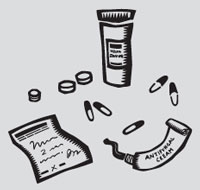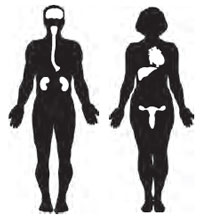Systemic Candidiasis and HIV Disease
January 2011
 |
Candidiasis can occur in the mouth, throat, windpipe (esophagus), vagina or on the skin. It can also spread throughout the body. While this is rare, it's also life-threatening. Recurrent and difficult to treat vaginal yeast infections are a sign of HIV disease progression in women.
What Causes Candidiasis?
Candida is normally found in small amounts in the mouth, vagina, digestive tract and skin. Other bacteria and the immune system keep it from becoming a problem in healthy people.However, a weak immune system makes it easier for Candida to grow and cause infection. In HIV disease, the most serious outbreaks occur when CD4 counts are very low (below 100). Here, candidiasis can recur and be difficult to treat.
Factors including diabetes, pregnancy, iron, folate, and vitamin B12 or zinc deficiency, and use of antihistamines can increase the risk of fungal infections. Chemotherapy, stress and depression can also cause or worsen candidiasis.
Infection in the VaginaVaginal candidiasis, called yeast infection or vaginitis, is an infection of the vulva and/or vagina. It causes a smelly, thick, white-yellow discharge that might occur with itching, burning and swelling. A bad case can make walking, peeing or sex very painful.Infection in the MouthOral candidiasis, or thrush, can occur without symptoms. The most common usually include discomfort in the mouth and throat, burning and an altered sense of taste (often described as "bad"). Creamy white or yellowish coatings or spots are also common. Thrush is rare at CD4s above 500, but outbreaks are more common as it drops to 100.Infection in the Throat and WindpipeEsophageal candidiasis is a serious condition on the list of AIDS-defining illnesses, affecting up to 1 in 5 people with AIDS. It often occurs together with thrush. Symptoms include chest pain, nausea and pain when swallowing. Coatings and spots may partly block the throat, which can make swallowing painful and cause people to lose weight. This can spread into the stomach and intestines.Infection of the SkinCutaneous candidiasis can infect skin in the armpits, groin, sex organs, fingernails, toenails and under the breasts. Bright red uneven eruptions appear in the folds of skin which may be coated by a white, wrinkled layer of tissue. Other symptoms include a mild burning.Infection Throughout BodySystemic candidiasis spreads throughout the body and can be life-threatening. Infection might include the brain, heart, kidneys, eyes, liver, genital tract and joints. This form occurs most often in people with low white blood cell counts (neutropenia). |
Diagnosis
Candidiasis is usually diagnosed by appearance and symptoms. Lab tests are usually done if the infection does not clear up after treatment. A doctor will use a small tube called an endoscopy to look into the windpipe for esophageal disease.Systemic candidiasis is very difficult to diagnose. Fungus found in the blood may come from a local infection like the mouth as well as from infection of internal organs. It may also only be briefly present in the blood even when an organ is infected.
Treatment
Many drugs are used, and they come in two types: topical (active only where it's applied) and systemic (active throughout the body). Topical treatment is the first choice for oral, vaginal or skin infections, and it generally works for mild-to-moderate cases. If they do not work, or if outbreaks occur often, systemic drugs may be needed. Systemic treatment is always used for esophageal or systemic disease.| Topical Therapy | |
Mouth RinsesMouth rinses are less effective as they only have contact with the mouth for a short time. However, they may be the best choice for someone with a very sore or dry mouth. Rinses should be swilled around the mouth for as long as possible and then swallowed. They are used at least 4 times a day and continued for a few days after symptoms have gone. The most widely used rinse is Mycostatin Oral Suspension (nystatin).LozengesFor oral symptoms, one or two lozenges or troches are taken 3-5 times a day. They should be sucked slowly and not chewed or swallowed whole. Common brands are Mycelex (clotrimazole) and Mycostatin (nystatin).Creams and OintmentsCreams and ointments are used for skin and nail infections. They can be used at the corners of the mouth or rubbed into affected areas of skin, including the labia. They should be applied 2-4 times a day by gentle and thorough massage. The length of therapy varies, but it often takes 10-20 days and should continue for a few days after the symptoms clear up.Products include Fungizone, Lotrimin, Lotrisone, Monistat-Derm, Mycelex, Mycolog-II, Mycostatin, Nizoral and Spectazole. Creams containing a steroid should not be used for children under 12. Some creams can be bought as a prescription or over the counter as products for athlete's foot or jock itch. Vaginal SuppositoriesVaginal suppositories or tablets are put into the vagina: once only clotrimazole or once a day for 3 days miconazole. Common brands are GyneLotrimin, Mycelex-G and Monistat 3. A single oral dose of fluconazole (Diflucan) is increasingly used for treating vaginal candidiasis. |
| Systemic Therapy | ||
KetoconazoleNizoral (ketoconazole) is taken at 200 or 400mg once a day with acidic food or beverage. Antacids should be avoided. It should also not be taken at the same time as other therapies that have a buffer or antacid, like Videx (didanosine, ddI). It may not be well absorbed in people with gut problems or who cannot eat very much.FungizoneFungizone (amphotericin B, AmB) is given directly into a vein to treat systemic candidiasis when other therapies fail or the infection is very aggressive. It can be very difficult to tolerate. People are usually given the drug until they start to improve (usually 2 weeks) and then switched to fluconazole at 200-400mg per day. Other forms of AmB are used when systemic infections become resistant or less responsive to standard therapy, including Amphotec and Abelcet. These may have fewer side effects than standard AmB, but all can be quite toxic.FluconazoleFluconazole is usually taken at 200mg the first day, then 100mg once a day thereafter. Treatment typically lasts 2 weeks for oral or therapyskin candidiasis and 3 weeks for esophageal infectionStudies suggest that fluconazole is more effective than ketoconazole, but some doctors prefer to treat with other drugs in order to save the potent fluconazole for later use, if necessary. Once fluconazole resistance develops, then treatment options are very limited. ItraconazoleItraconazole (Sporanox) appears to be at least as potent as ketoconazole and may be as good as fluconazole. It should be taken with acidic food or beverage. The dose is 200mg per day.Itraconazole oral solution is more effective and puts higher levels of the drug in the blood than the capsule. There are possible interactions between itraconazole and many HIV drugs. |
Related Stories
| More on Fungal Infections in HIV/AIDS |
| Candidiasis (Thrush) |
| More on Fungal Infections |


No comments:
Post a Comment